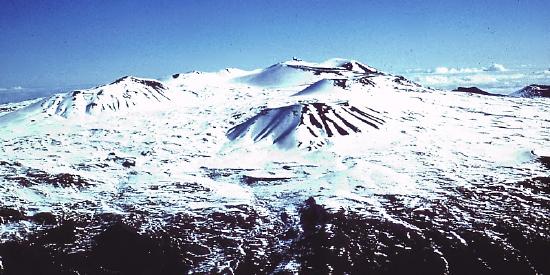1.5.2: Dalton's Law
- Page ID
- 92705
Make sure you thoroughly understand the following essential ideas which have been presented below.
- One mole of a gas occupies a volume of 22.4 L at STP (standard temperature and pressure, 273K, 1 atm = 103 kPa.)
- The above fact allows us to relate the measurable property of the density of a gas to its molar mass.
- The composition of a mixture of gases is commonly expressed in terms mole fractions; be sure you know how to calculate them.
- Dalton's Law of partial pressures says that every gas in a mixture acts independently, so the total pressure a gas exerts against the walls of a container is just the sum of the partial pressures of the individual components.
Although all gases closely follow the ideal gas law PV = nRT under appropriate conditions, each gas is also a unique chemical substance consisting of molecular units that have definite masses. In this lesson we will see how these molecular masses affect the properties of gases that conform to the ideal gas law. Following this, we will look at gases that contain more than one kind of molecule— in other words, mixtures of gases. We begin with a review of molar volume and the E.V.E.N. principle, which is central to our understanding of gas mixtures.
The Molar Volume of a Gas
You will recall that the molar mass of a pure substance is the mass of 6.02 x 1023 (Avogadro's number) of particles or molecular units of that substance. Molar masses are commonly expressed in units of grams per mole (g mol–1) and are often referred to as molecular weights. Equal volumes of gases, measured at the same temperature and pressure, contain equal numbers of molecules (this is the "EVEN" principle, more formally known as Avogadro's law.) Standard temperature and pressure: 273K, 1 atm
The magnitude of this volume will of course depend on the temperature and pressure, so as a means of convenient comparison it is customary to define a set of conditions T = 273 K and P = 1 atm as standard temperature and pressure, usually denoted as STP. Substituting these values into the ideal gas equation of state and solving for V yields a volume of 22.414 liters for 1 mole.
What would the volume of one mole of air be at 20°C on top of Mauna Kea, Hawa'ii (altitude 4.2 km) where the air pressure is approximately 60 kPa?

Scoria and cinder cones on Mauna Kea's summit in winter. (Public Domain; USGS)
Solution
Apply Boyle's and Charles' laws as successive correction factors to the standard sea-level pressure of 101.3 kPa:

The standard molar volume 22.4 L mol–1 is valid only at STP. The molar volume at other temperatures and pressures can easily be found by simple proportion. The molar volume of a substance can tell us something about how much space each molecule occupies, as the following example shows.
Estimate the average distance between the molecules in a gas at 1 atm pressure and 0°C.
Solution
Consider a 1-cm3 volume of the gas, which will contain
\[\dfrac{6.02 \times 10^{23} \;mol^{–1}}{22,400\; cm^3 \;mol^{–1}} = 2.69 \times 10^{19} cm^{-3} \nonumber\]
The volume per molecule (not the same as the volume of a molecule, which for an ideal gas is zero!) is just the reciprocal of this, or \(3.72 \times 10^{-20}\, cm^3\). Assume that the molecules are evenly distributed so that each occupies an imaginary box having this volume. The average distance between the centers of the molecules will be defined by the length of this box, which is the cube root of the volume per molecule:
\[(3.72 \times 10^{–20})^{1/3} = 3.38 \times 10^{–7}\, cm = 3.4\, nm \nonumber\]
Under conditions at which the ideal gas model is applicable (that is, almost always unless you are a chemical engineer dealing with high pressures), "a molecule is a molecule", so the volume of Avogadro's number of molecules will be independent of the composition of the gas. The reason, of course, is that the volume of the gas is mostly empty space; the volumes of the molecules themselves are negligible.
Expressing the Composition of a Gas Mixture
Because most of the volume occupied by a gas consists of empty space, there is nothing to prevent two or more kinds of gases from occupying the same volume. Homogeneous mixtures of this kind are generally known as solutions, but it is customary to refer to them simply as gaseous mixtures. We can specify the composition of gaseous mixtures in many different ways, but the most common ones are by volumes and by mole fractions.
Volume Fractions
From Avogadro's Law we know that "equal volumes contains equal numbers of molecules". This means that the volumes of gases, unlike those of solids and liquids, are additive. So if a partitioned container has two volumes of gas A in one section and one mole of gas B in the other (both at the same temperature and pressure), and we remove the partition, the volume remains unchanged.

Volume fractions are often called partial volumes:
\[V_i = \dfrac{v_i}{\sum v_i}\]
Don't let this type of notation put you off! The summation sign Σ (Greek Sigma) simply means to add up the v's (volumes) of every gas. Thus if Gas A is the "i-th" substance as in the expression immediately above, the summation runs from i=1 through i=2. Note that we can employ partial volumes to specify the composition of a mixture even if it had never actually been made by combining the pure gases.
When we say that air, for example, is 21 percent oxygen and 78 percent nitrogen by volume, this is the same as saying that these same percentages of the molecules in air consist of O2 and N2. Similarly, in 1.0 mole of air, there is 0.21 mol of O2 and 0.78 mol of N2 (the other 0.1 mole consists of various trace gases, but is mostly neon.) Note that you could never assume a similar equivalence with mixtures of liquids or solids, to which the E.V.E.N. principle does not apply.
Dalton's Law of Partial Pressures
The ideal gas equation of state applies to mixtures just as to pure gases. It was in fact with a gas mixture, ordinary air, that Boyle, Gay-Lussac and Charles did their early experiments. The only new concept we need in order to deal with gas mixtures is the partial pressure, a concept invented by the English chemist John Dalton (1766-1844). Dalton reasoned that the low density and high compressibility of gases indicates that they consist mostly of empty space; from this it follows that when two or more different gases occupy the same volume, they behave entirely independently.
The contribution that each component of a gaseous mixture makes to the total pressure of the gas is known as the partial pressure of that gas.
The usual way of stating Dalton's Law of Partial Pressures is
The total pressure of a gas is the sum of the partial pressures of its components
which is expressed algebraically as
\[P_{total}=P_1+P_2+P_3 ... = \sum_i P_i\]
or, equivalently
\[ P_{total} = \dfrac{RT}{V} \sum_i n_i\]
Application of Dalton's Law: Scuba diving
Our respiratory systems are designed to maintain the proper oxygen concentration in the blood when the partial pressure of O2 is 0.21 atm, its normal sea-level value. Below the water surface, the pressure increases by 1 atm for each 10.3 m increase in depth; thus a scuba diver at 10.3 m experiences a total of 2 atm pressure pressing on the body. In order to prevent the lungs from collapsing, the air the diver breathes should also be at about the same pressure.

But at a total pressure of 2 atm, the partial pressure of \(O_2\) in ordinary air would be 0.42 atm; at a depth of 100 ft (about 30 m), the \(O_2\) pressure of .8 atm would be far too high for health. For this reason, the air mixture in the pressurized tanks that scuba divers wear must contain a smaller fraction of \(O_2\). This can be achieved most simply by raising the nitrogen content, but high partial pressures of N2 can also be dangerous, resulting in a condition known as nitrogen narcosis. The preferred diluting agent for sustained deep diving is helium, which has very little tendency to dissolve in the blood even at high pressures.


